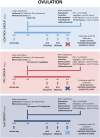Differential effects of the immunosuppressive calcineurin inhibitors cyclosporine-A and tacrolimus on ovulation in a murine model
- PMID: 33997300
- PMCID: PMC8111498
- DOI: 10.1093/hropen/hoab012
Differential effects of the immunosuppressive calcineurin inhibitors cyclosporine-A and tacrolimus on ovulation in a murine model
Abstract
Study question: Do therapeutic levels of cyclosporine-A and tacrolimus affect ovulation in a rat gonadotrophin-induced ovulation model?
Summary answer: Cyclosporine-A, but not tacrolimus, decreases ovulation rate when administered for 5 days before induced ovulation.
What is known already: The mainstays of immunosuppression in solid organ transplantation, to prevent rejection, are the calcineurin inhibitors cyclosporine-A or tacrolimus. These drugs could potentially affect fertility in transplanted patients. Since ovulation is an inflammation-like process with pivotal roles for several immune cells and modulators, it is possible that the calcineurin inhibitors, with broad effects on the immune system, could interfere with this sensitive, biological process.
Study design size duration: Experimental design at university-based animal facilities. A total of 45 immature Sprague-Dawley rats were used. The study was carried out over 3 months.
Participants/materials setting methods: Immature Sprague-Dawley rats (n = 45) were randomly assigned to receive equivalent doses of tacrolimus (0.5 mg/kg/day; TAC), cyclosporine-A (10 mg/kg/day; CyA) or vehicle (Control). Ovarian hyperstimulation was induced with 10 IU of equine chorionic gonadotrophin, and ovulation was triggered with 10 IU of hCG. Oocytes were retrieved from the oviducts and ovulation rates were calculated. Various subpopulations of white blood cells were counted in peripheral blood and ovarian tissue samples.
Main results and the role of chance: Animals in the CyA group showed a lower ovulation rate when compared to the TAC and Control groups (CyA: mean 9 oocytes (range 0-22); TAC: 21 oocytes (8-41); Control: 22 oocytes (6-39); P = 0.03). Regarding counts of the white blood cell subpopulations and resident neutrophils in the ovary, no significant differences were observed between the groups.
Limitations reasons for caution: Although the ovulation process is highly conserved within species, the differences between rodents and humans may limit the external translatability of the study.
Wider implications of the findings: These findings suggest that tacrolimus should be the preferred calcineurin inhibitor of choice in transplanted patients who are aiming for pregnancy.
Study funding/competing interests: Swedish Research Council and ALF of Sahlgrenska Academy, Sweden. Rio Hortega Grant from the Instituto de Salud Carlos III, Spain (CM09/00063). There are no conflicts of interest.
Keywords: calcineurin; cyclosporine-A; immunosuppression; ovary; ovulation; rat; tacrolimus; transplantation.
© The Author(s) 2021. Published by Oxford University Press on behalf of European Society of Human Reproduction and Embryology.
Figures




Similar articles
-
Kisspeptin treatment induces gonadotropic responses and rescues ovulation in a subset of preclinical models and women with polycystic ovary syndrome.Hum Reprod. 2019 Dec 1;34(12):2495-2512. doi: 10.1093/humrep/dez205. Hum Reprod. 2019. PMID: 31820802 Free PMC article. Clinical Trial.
-
In vivo intrabursal administration of bioactive lipid sphingosine-1-phosphate enhances vascular integrity in a rat model of ovarian hyperstimulation syndrome.Mol Hum Reprod. 2017 Jun 1;23(6):417-427. doi: 10.1093/molehr/gax021. Mol Hum Reprod. 2017. PMID: 28379469
-
The polycystic ovary syndrome-associated gene Yap1 is regulated by gonadotropins and sex steroid hormones in hyperandrogenism-induced oligo-ovulation in mouse.Mol Hum Reprod. 2017 Oct 1;23(10):698-707. doi: 10.1093/molehr/gax046. Mol Hum Reprod. 2017. PMID: 28961951
-
What is the calcineurin inhibitor of choice for pediatric renal transplantation?Pediatr Transplant. 2004 Oct;8(5):437-44. doi: 10.1111/j.1399-3046.2004.00201.x. Pediatr Transplant. 2004. PMID: 15367278 Review.
-
[Cytochrome P450 3A polymorphism and its importance in cyclosporine and tacrolimus therapy in transplanted patients].Ceska Slov Farm. 2007 Oct;56(5):220-4. Ceska Slov Farm. 2007. PMID: 18064802 Review. Czech.
Cited by
-
The Molecular Quality and Mitochondrial Activity of Porcine Cumulus-Oocyte Complexes Are Affected by Their Exposure to Three Endocrine-Active Compounds under 3D In Vitro Maturation Conditions.Int J Mol Sci. 2022 Apr 20;23(9):4572. doi: 10.3390/ijms23094572. Int J Mol Sci. 2022. PMID: 35562963 Free PMC article.
References
-
- Atilla G, Sorsa T, Ronka H, Emingil G.. Matrix metalloproteinases (MMP-8 and -9) and neutrophil elastase in gingival crevicular fluid of cyclosporin-treated patients. J Periodontol 2001;72:354–360. - PubMed
-
- Bayer J, Das NA, Baisden CE, Rani M, DeArmond DT, Peters JI, Johnson SB.. Effect of inhaled tacrolimus on ischemia reperfusion injury in rat lung transplant model. J Thorac Cardiovasc Surg 2013;146:1213–1219; discussion 1219. - PubMed
-
- Brännström M, Johannesson L, Bokström H, Kvarnström N, Mölne J, Dahm-Kähler P, Enskog A, Milenkovic M, Ekberg J, Diaz-Garcia C.. et al. Livebirth after uterus transplantation. The Lancet 2015;385:607–616. - PubMed
LinkOut - more resources
Full Text Sources
Other Literature Sources
Research Materials
